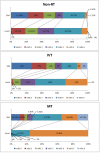Comparison of the Clinical Outcomes Between Reperfusion and Non-Reperfusion Therapy in Elderly Patients with Acute Ischemic Stroke
- PMID: 39006937
- PMCID: PMC11246639
- DOI: 10.2147/CIA.S464010
Comparison of the Clinical Outcomes Between Reperfusion and Non-Reperfusion Therapy in Elderly Patients with Acute Ischemic Stroke
Abstract
Purpose: To investigate the benefit (90-day mRS score) and rate of major complications (early symptomatic intracranial hemorrhage-SICH) after reperfusion therapy (RT) (including intravenous thrombolysis -IVT and mechanical thrombectomy -MT) in patients over 80 years with acute ischemic stroke (AIS).
Patients and methods: AIS patients aged over 80 admitted to Huizhou Central People's Hospital from September 2018 to 2023 were included in this study. Data on SICH, NIHSS, and mRS were analyzed. A good prognosis was defined as a mRS ≤ 2 or recovery to pre-stroke status at 90 days.
Results: Of 209 patients, 80 received non-RT, 100 received IVT and 29 underwent MT. The non-RT group had the lowest baseline NIHSS while the MT group had the highest (non-RT 6.0 vs IVT 12.0 vs MT 18.0, P <0.001). Higher NIHSS was associated with increased SICH risk (OR 1.083, P=0.032), while RT was not (OR 5.194, P=0.129). The overall SICH rate in the RT group was higher but not significantly different after stratification by stroke severity. Poor prognosis was associated with higher admission NIHSS, stroke due to large artery atherosclerosis (LAA) combined with cardioembolism (CE), and stroke-associated pneumonia (SAP) (OR 0.902, P<0.001; OR 0.297, P=0.029; OR 0.103, P<0.001, respectively). The RT group showed a greater reduction in NIHSS (delta NIHSS) than the non-RT group (non-RT 2.0 vs IVT 4.0 vs MT 6.0, P<0.005). For severe AIS, the IVT group had a better prognosis at 90 days (non-RT 0% vs IVT 38.2%, P=0.039). No 90-day mortality difference was found between groups after stratification.
Conclusion: Stroke severity, rather than RT, is an independent risk factor for SICH in AIS patients over 80. RT in severe stroke patients improves NIHSS at 90 days, suggesting RT is safe and effective in this demographic. Further studies with larger samples are required to confirm these findings.
Keywords: acute ischemic stroke; elderly; intravenous thrombolysis; mechanical thrombectomy; symptomatic intracranial hemorrhage; therapeutic efficacy.
© 2024 Luo et al.
Conflict of interest statement
The authors report no conflicts of interest in this work.
Figures
Similar articles
-
Ischemic stroke and reperfusion therapies in diabetic patients.Neurol Sci. 2022 Jul;43(7):4335-4348. doi: 10.1007/s10072-022-05935-x. Epub 2022 Feb 11. Neurol Sci. 2022. PMID: 35146566
-
Comparison of combined intravenous and intra-arterial thrombolysis with intravenous thrombolysis alone in stroke patients undergoing mechanical thrombectomy: a propensity-matched analysis.J Neurointerv Surg. 2025 Jun 1;17(e2):e261-e268. doi: 10.1136/jnis-2024-021975. J Neurointerv Surg. 2025. PMID: 39179373
-
Safety Outcomes of Mechanical Thrombectomy Versus Combined Thrombectomy and Intravenous Thrombolysis in Tandem Lesions.Stroke. 2023 Oct;54(10):2522-2533. doi: 10.1161/STROKEAHA.123.042966. Epub 2023 Aug 21. Stroke. 2023. PMID: 37602387 Free PMC article.
-
Bridging thrombolysis improves survival rates at 90 days compared with direct mechanical thrombectomy alone in acute ischemic stroke due to basilar artery occlusion: a systematic review and meta-analysis of 1096 patients.J Neurointerv Surg. 2023 Oct;15(10):1039-1045. doi: 10.1136/jnis-2022-019510. Epub 2022 Sep 29. J Neurointerv Surg. 2023. PMID: 36175014
-
Early tirofiban administration for patients with acute ischemic stroke treated with intravenous thrombolysis or bridging therapy: Systematic review and meta-analysis.Clin Neurol Neurosurg. 2022 Nov;222:107449. doi: 10.1016/j.clineuro.2022.107449. Epub 2022 Sep 21. Clin Neurol Neurosurg. 2022. PMID: 36162161
References
-
- Chinese Society of Neurology, Chinese Stroke Society, Neurovascular Intervention Group of Chinese Society of Neurology. Chinese guidelines for the endovascular treatment of acute ischemic stroke 2022. Chin J Neurol. 2022;55(6):565–580. doi:10.3760/cma.j.cn113694-20220225-00137 - DOI
-
- Report on stroke prevention and treatment in China Writing Group. Brief report on stroke prevention and treatment in China, 2020. Chin J Cerebrovasc Dis. 2022;19(2):136–144. doi:10.3969/j.issn.1672-5921.2022.02.011 - DOI
-
- Wang YJ, Li ZX, Gu HQ, et al. China Stroke Statistics: an update on the 2019 report from the national center for healthcare quality management in neurological diseases, China national clinical research center for neurological diseases, the Chinese stroke association, national center for chronic and non-communicable disease control and prevention, Chinese center for disease control and prevention and institute for global neuroscience and stroke collaborations. Stroke Vasc Neurol. 2022;7(5):415–450. doi:10.1136/svn-2021-001374 - DOI - PMC - PubMed
Publication types
MeSH terms
Substances
LinkOut - more resources
Full Text Sources
Medical
Miscellaneous




